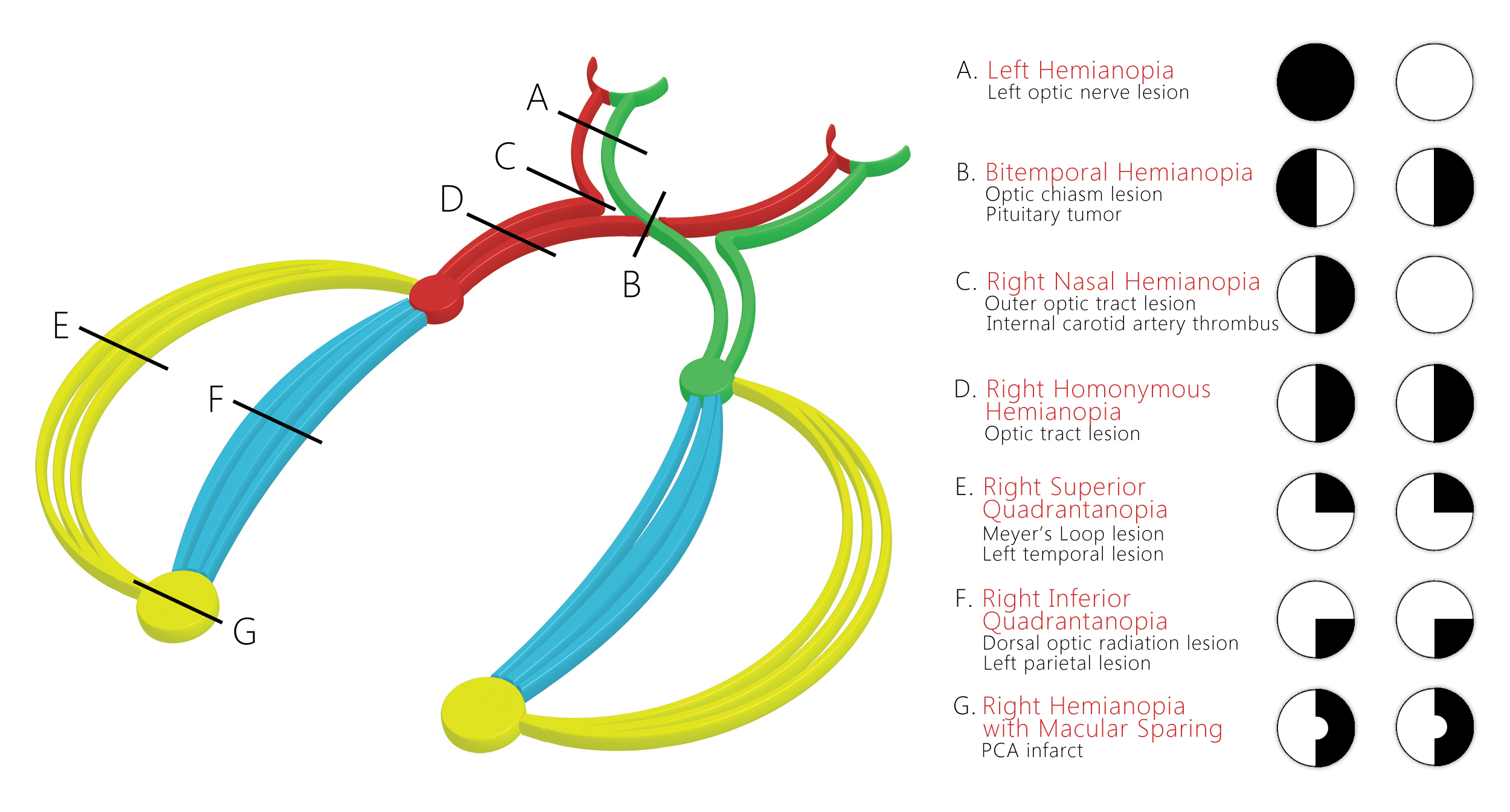WBR0586: Difference between revisions
Rim Halaby (talk | contribs) No edit summary |
Rim Halaby (talk | contribs) No edit summary |
||
| Line 27: | Line 27: | ||
Superior [[quadrantanopia]] is characterized by loss of vision in the upper quadrant of the visual field. It usually occurs with contralateral temporal lesions due to the interruption of the left [[Meyer's loop]]. Although classically associated with the [[temporal lobe]], it can also occur with certain lesions to the contralateral [[lateral geniculate nucleus]] (LGN) and certain localized lesions to the contralateral [[visual cortex]]. Superior quadrantanopia is commonly seen in patients with direct temporal lobe trauma, temporal lobe tumors commonly metastatic, or [[MCA]] infarcts. | Superior homonymous [[quadrantanopia]] is characterized by loss of vision in the upper quadrant of the visual field. It usually occurs with contralateral temporal lesions due to the interruption of the left [[Meyer's loop]]. Although classically associated with the [[temporal lobe]], it can also occur with certain lesions to the contralateral [[lateral geniculate nucleus]] (LGN) and certain localized lesions to the contralateral [[visual cortex]]. Superior quadrantanopia is commonly seen in patients with direct temporal lobe trauma, temporal lobe tumors commonly metastatic, or [[MCA]] infarcts. | ||
| Line 35: | Line 35: | ||
References: | References: | ||
Jacobson DM. The localizing value of a quadrantanopia. Arch Neurol. 1997;54(4):401-4. | Jacobson DM. The localizing value of a quadrantanopia. Arch Neurol. 1997;54(4):401-4. | ||
|AnswerAExp= | |AnswerA=Parietal lobe | ||
|AnswerB= | |AnswerAExp=Parietal lobe lesions are usually associated with inferior homonymous quadrananopia due to the interruption of the dorsal optic radiations (Baum's loop). Parietal lobe lesions do not usually cause superior quadrantanopia except if large enough to cause a mass effect. | ||
|AnswerBExp= | |AnswerB=Frontal lobe | ||
|AnswerC= | |AnswerBExp=Frontal lobe lesions usually cause visual field defects by compression the optic tracts or the optic nerve causing unilateral anopia. Frontal lesions can also affect the frontal eye fields involved in eye movements, such as voluntary saccades and pursuit. Frontal lobe lesions do not usually cause quadrantanopia. | ||
|AnswerCExp= | |AnswerC=Temporal lobe | ||
|AnswerD= | |AnswerCExp=Temporal lobe lesions usually present with visual field disturbances similar to our patient. Superior quadrantanopia is seen in temporal lesions due to the interruption of the Meyer's loop | ||
|AnswerDExp= | |AnswerD=Occipital lobe | ||
|AnswerE= | |AnswerDExp=Occipital lobe lesions usually cause homonymous hemianopia, although cases of quadrantanopia are also encountered. However, superior quadrantanopia is classically seen in temporal lobe lesions. | ||
|AnswerEExp= | |AnswerE=Cerebellum | ||
|AnswerEExp=The cerebellum is not associated with visual field defects. | |||
|RightAnswer=C | |RightAnswer=C | ||
|WBRKeyword=Upper quadrantopia, Temporal lesions, Visual field defects, | |WBRKeyword=Upper quadrantopia, Temporal lesions, Visual field defects, | ||
|Approved=No | |Approved=No | ||
}} | }} | ||
Revision as of 15:54, 6 October 2013
| Author | [[PageAuthor::Rim Halaby, M.D. [1]]] |
|---|---|
| Exam Type | ExamType::USMLE Step 1 |
| Main Category | MainCategory::Pathophysiology |
| Sub Category | SubCategory::Head and Neck, SubCategory::Neurology |
| Prompt | [[Prompt::A 45 year old woman with past medical history significant for resected breast cancer presents to the emergency department after suffering a tonic-clonic seizure lasting 3 minutes. She explains that she was walking her dog and then found herself on the ground with several people surrounding her, not knowing what had happened. The patient explains that she had been recovering well after her last chemotherapy cycle, and had no complaints except an annoying area of visual field disturbance she noticed recently. On physical exam, you notice the pattern of visual loss shown below. You order a brain MRI that shows a intracranial lesion with high suspicion for metastasis. Where is the most likely location of the lesion given the patient's symptoms? |
| Answer A | AnswerA::Parietal lobe |
| Answer A Explanation | [[AnswerAExp::Parietal lobe lesions are usually associated with inferior homonymous quadrananopia due to the interruption of the dorsal optic radiations (Baum's loop). Parietal lobe lesions do not usually cause superior quadrantanopia except if large enough to cause a mass effect.]] |
| Answer B | AnswerB::Frontal lobe |
| Answer B Explanation | [[AnswerBExp::Frontal lobe lesions usually cause visual field defects by compression the optic tracts or the optic nerve causing unilateral anopia. Frontal lesions can also affect the frontal eye fields involved in eye movements, such as voluntary saccades and pursuit. Frontal lobe lesions do not usually cause quadrantanopia.]] |
| Answer C | AnswerC::Temporal lobe |
| Answer C Explanation | AnswerCExp::Temporal lobe lesions usually present with visual field disturbances similar to our patient. Superior quadrantanopia is seen in temporal lesions due to the interruption of the Meyer's loop |
| Answer D | AnswerD::Occipital lobe |
| Answer D Explanation | AnswerDExp::Occipital lobe lesions usually cause homonymous hemianopia, although cases of quadrantanopia are also encountered. However, superior quadrantanopia is classically seen in temporal lobe lesions. |
| Answer E | AnswerE::Cerebellum |
| Answer E Explanation | AnswerEExp::The cerebellum is not associated with visual field defects. |
| Right Answer | RightAnswer::C |
| Explanation | [[Explanation::
|
| Approved | Approved::No |
| Keyword | WBRKeyword::Upper quadrantopia, WBRKeyword::Temporal lesions, WBRKeyword::Visual field defects |
| Linked Question | Linked:: |
| Order in Linked Questions | LinkedOrder:: |
